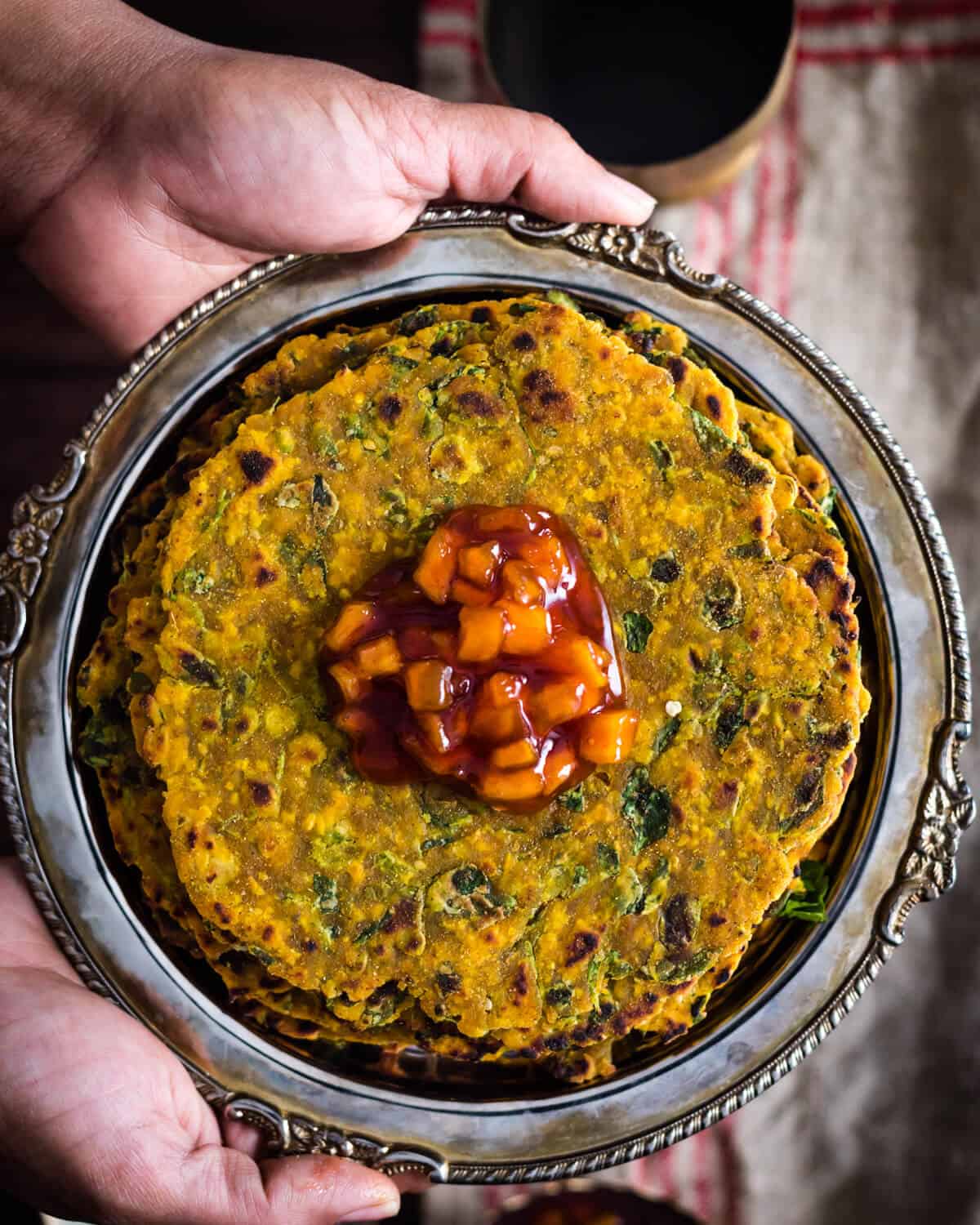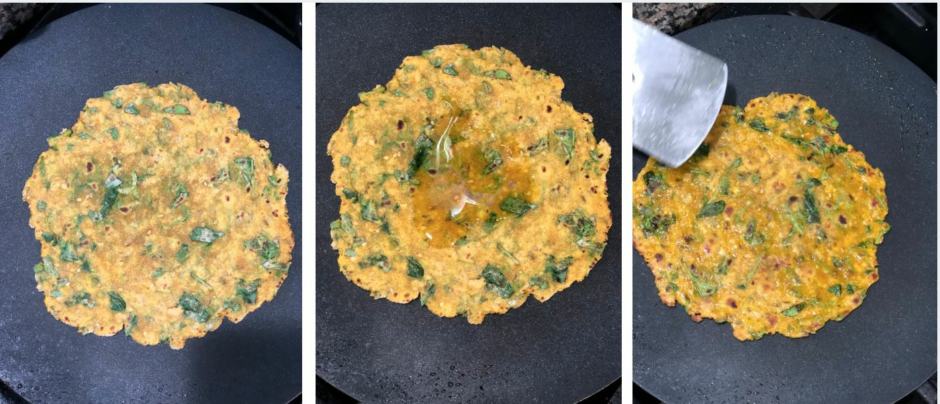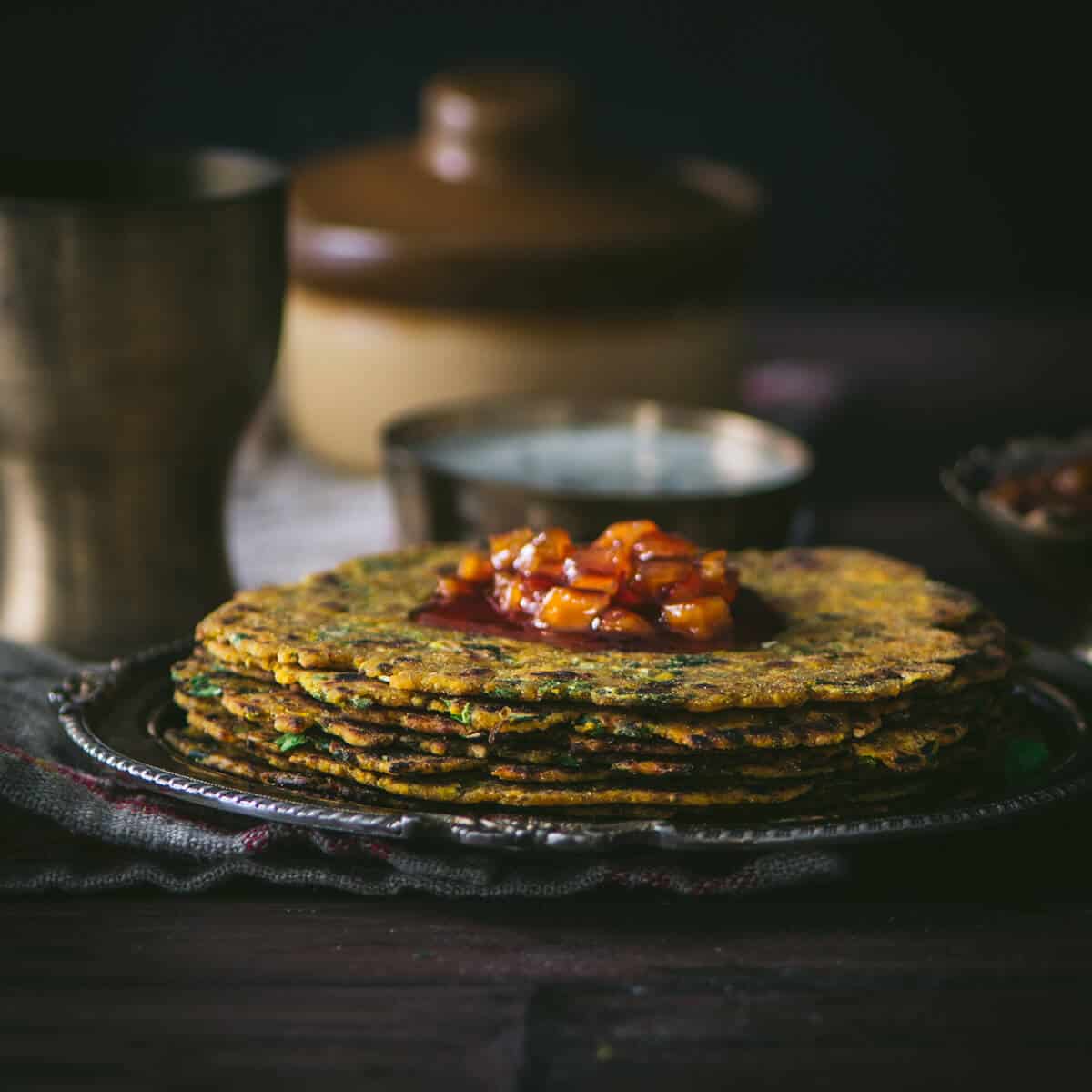Methi na thepla combines fresh fenugreek leaves, whole wheat flour, and fragrant spices to make this delicious spiced Indian flatbread recipe. Ideal for a nutritious breakfast or snack, convenient for travel, or as a tasty inclusion in lunch boxes, the Gujarati methi thepla hits the spot each time – due to its unique flavor and noteworthy shelf life.

What’s methi thepla?
Thepla, an unleavened bread made with wheat flour, often encompasses a mixture of finely chopped leafy greens or grated vegetables, corresponding to bottle gourd or radish (mooli), adding each nutrition and flavor.
Methi thepla, a variant of this bread, incorporates fenugreek leaves (methi) and is a outstanding dish in Gujarati cuisine. While it shares some characteristics with parathas, methi thepla stands out with its distinct composition.
In preparing Gujarati methi thepla, finely chopped fenugreek leaves are combined with yogurt and spices after which mixed into whole wheat flour. The important thing ingredient, methi, is well known for its unique and fragrant flavor, making this thepla a flavorful and healthful selection.
Are thepla and parathas the identical thing?
Although thepla and paratha are each Indian flatbreads which will appear to have similarities, here’s how they’re different –
- Flour composition: Parathas are traditionally made using only whole wheat flour, while thepla often incorporates a mix of flours like bajra (millet) and besan (Bengal gram flour), adding to their unique texture and taste.
- Dough preparation: For paratha, the dough is usually made with water. In contrast, thepla dough is kneaded with yogurt.
- Shelf life: A notable difference lies of their shelf life. Parathas often don’t last long without refrigeration. However, theplas have a for much longer shelf life, making them a great selection for long journeys.
- Cooking technique: Each are cooked on a griddle and shallow fried in oil or ghee. Nevertheless, while parathas are allowed to puff up, which helps create their layers, Theplas are pressed down on each side with a spatula during cooking, leading to a crispier texture.
How does methi thepla taste?
Methi thepla beautifully balances spicy and savory flavors, creating a novel and appealing taste mainly derived from fenugreek leaves (methi). Although methi leaves are naturally bitter and might be overpowering by themselves, their addition to the thepla dough transforms the dish. The leaves impart a pleasant aroma and a wealthy, complex flavor, very much like their role in enhancing dishes like Aloo methi.

The right way to make methi thepla
As a South Indian in a Gujarati-speaking neighborhood, I grew up amidst a fusion of culinary traditions, where dhokla, khaman, and theplas were as familiar as idlis and dosas. Though we didn’t make them at home, I had my fill of theplas from my friend’s lunch boxes.
After moving to the US, my craving for theplas led to several experiments within the kitchen until I developed a recipe I really enjoyed, one which I relied on for years. Nevertheless, this modified once I tasted the theplas made by a pricey friend. Her theplas were a category apart, and that’s why I actually have updated my old recipe with hers.
Each time we take a road trip, I whip up a batch of 20-25 theplas for us to enjoy on the road. It is ideal for times when you must take a break from eating out. They store well for as much as every week without being refrigerated, and that’s what makes them a well-liked travel food.
Note – This recipe makes around 28-30 theplas. They refrigerate and freeze well. That’s why I make an enormous batch each time.
Equipment needed
- Large mixing bowl
- Rolling pin
- Hot tawa (griddle) for cooking
Step-by-step guide – Methi na thepla
Step 1 – Add whole wheat flour, yogurt, and oil in a bowl and blend them together. Add all of the remaining ingredients except methi leaves and water till they’re well combined.

Step 2 – Add methi leaves and knead the mixture right into a dough using water as needed.

Step 3 – Divide the dough into 30 equal-sized balls.[Cover the dough while working with a damp cloth to prevent them from drying]. Roll out each ball right into a circle (roughly 5-6 inch diameter circle), dusting it with flour as needed to forestall it from sticking.

Step 4 – Heat a griddle over medium heat. Dust off excess flour from the thepla by placing it on the palm of 1 hand after which flipping it onto the palm of your other hand. Repeat this process 3-4 times. Place the thepla on the new griddle. When one side starts to bubble up (approx 60 seconds later), flip it to the opposite side, fastidiously pressing the thepla down with a cloth or a ladle to be certain that it’s fully cooked.
Flip the thepla; add a teaspoon of oil to the pan and cook on each side for about 15 seconds each. Use a spatula to press the sides to make sure the perimeters are cooked through.

Variations
Keeping the remainder of the ingredients and the method same, listed below are just a few variations to the thepla recipe that you may try at home
- Bottle gourd / Lauki thepla – Add 1 cup of grated dudhi or bottle gourd together with whole wheat flour and the remainder of the ingredients on this recipe to form a dough.
- Radish or mooli theplas – It’s also possible to add a cup of grated radish/muli to the ingredients.
- Spinach thepla – Add 1-2 cups of chopped spinach to the dough mix as an alternative of methi leaves.
- Vegan methi thepla – For a vegan version, substitute dairy yogurt with either water or a vegan yogurt alternative.
What to serve with methi thepla?
Methi thepla is frequently served hot or at room temperature, accompanied by chundo (a sweet and tangy mango pickle). It’s also possible to serve it with green chutney or plain yogurt. They’re perfect at any time of the day and pair well with masala chai.
The right way to prep ahead
One of the best approach to prep for this healthy spiced flatbread recipe is to make the dough ahead of time. Follow the steps for making the dough as listed within the instructions, after which store it in either the refrigerator or the freezer.
- Refrigerated dough stays well in an air-tight container for as much as 3 days.
- The frozen dough keeps for a month.
- Bring the dough to room temperature before rolling out methi theplas.
Storage instructions
After cooling down completely, your methi thepla might be stored at room temperature in an air-tight container for 1-2 days if made with yogurt. If prepared without yogurt, it may possibly last for about 7-10 days, unrefrigerated.
For prolonged storage, you too can refrigerate or freeze the leftover thepla.
- Refrigerator – When cooled and placed in an air-tight container, the thepla lasts for 4-5 days within the fridge.
- Freezer – Thepla keeps for 2-3 months when frozen. I like to recommend separating them with parchment paper when freezing, or they’ll stick together.
- Reheat – For refrigerated theplas, reheat in a microwave (15-20 seconds) or reheat in a tava / skillet kept over medium heat. For frozen theplas, use a tava/skillet to reheat – no have to thaw beforehand.
The right way to make methi thepla for travel?
When cooking thepla for traveling or storing for greater than every week, make the dough with water as an alternative of yogurt. Also, add a further 2 tablespoons of oil to the dough to forestall the theplas from becoming too dry or going off. If made and stored properly, theplas can easily last 7-10 days without refrigeration.
How do you make methi thepla soft?
Theplas are frequently not as soft as rotis are, but should you prefer soft theplas, it is best to knead the dough with 2-3 tablespoons of oil to make the dough softer, resulting in softer theplas.
Can we substitute Methi leaves with Kasoori methi?
Kasuri methi (dried fenugreek leaves) are about 3 times stronger than fresh leaves. So be certain that you employ 1/third the amount should you are substituting for fresh fenugreek leaves.
What number of calories are in methi thepla?
Should you follow this recipe, each thepla comes out to be 137 calories.
Tips about preserving methi leaves
Storing methi (fenugreek) leaves properly ensures they continue to be fresh and retain their flavor for an extended period. Here’s how you’ll be able to store them:
- Rinse and dry:
- Start off by chopping off the roots. They’ll contain soil sometimes.
- Separate the leaves from the stems. Discard the stems as they have an inclination to be bitter.
- Rinse the methi leaves thoroughly under cold water to remove any dirt or impurities.
- Gently pat them dry with a clean kitchen towel or paper towel. It’s necessary to remove as much moisture as possible to avoid them from going bad quickly.
- Wrap in paper towels:
- Lay out a dry paper towel and place the methi leaves in a single layer on it.
- Gently wrap the paper towel across the leaves. This helps absorb any excess moisture.
- Store in an airtight container or Ziploc:
- Place the wrapped methi leaves in an airtight container or a zip-lock plastic bag.
- If using a container, ensure it’s dry and clean before adding the leaves.
- Refrigeration:
- Store the container or plastic bag within the refrigerator, preferably within the vegetable crisper section.
- This method typically keeps methi leaves fresh for about every week.
- Freezing (for longer storage):
- For longer storage, you’ll be able to freeze methi leaves.
- Dry them thoroughly, then store them in freezer-safe bags or containers.
- Frozen methi leaves can last several months. No have to thaw before using.
- Drying (Alternative method):
- Methi leaves will also be dried for long-term storage.
- Spread the leaves out in a single layer in a dry, well-ventilated area away from direct sunlight.
- Once completely dried, store them in an airtight container in a cool, dry place.
- Soak them in warm water for just a few minutes before using it.

There you’ve got it – a straightforward yet delightful methi thepla recipe. It’s a beautiful approach to bring a chunk of Indian culinary tradition into your kitchen. Give it a try, experiment with accompaniments, and don’t forget to share your Gujarati thepla adventures with us! Joyful cooking!

Click on the celebrities to rate!
Gujarati Methi Thepla Recipe (With Step-by-Step Photos)
Methi na thepla – Learn to make this delicious spiced Indian flatbread that you may enjoy any time of the day. This Gujarati thepla preserves rather well making it perfect for long-distance travel.
Pin
Print
Save
Email
Prevent your screen from going dark
-
Mix together all of the ingredients except methi leaves and water till they’re well combined. Add methi leaves and knead the mixture right into a dough using water as needed.
-
Divide the dough into 30 equal sized balls.[Cover the dough while working with a damp cloth to prevent them for drying]
-
Roll out each ball right into a circle (roughly 5-6 inch diameter circle) dusting it with flour as needed to forestall them from sticking.
-
Heat a griddle over medium heat.
-
Dust off excess flour from the thepla by placing it on the palm of 1 hand after which flipping it onto the palm of your other hand. Repeat this process 3-4 times. Place the thepla on the new griddle.
-
When one side starts to bubble up (approx 60 seconds later), flip it to the opposite side fastidiously pressing the thepla down with a cloth or a ladle to be certain that it’s fully cooked.
-
Flip the thepla and add a teaspoon of oil to the pan and cook on each side for about 15 seconds each. Use a spatula to press the sides to make sure the perimeters are cooked through.
-
Serve hot with chundo.
Disclaimer: Approximate dietary information is provided as a courtesy and might vary depending on the precise ingredients/brands used. If you’ve got health issues, please work with a registered dietician or nutritionist.
Calories: 137kcalCarbohydrates: 17gProtein: 5gFat: 6gSaturated Fat: 1gPolyunsaturated Fat: 1gMonounsaturated Fat: 3gCholesterol: 1mgSodium: 271mgPotassium: 93mgFiber: 3gSugar: 2gVitamin A: 88IUVitamin C: 2mgCalcium: 207mgIron: 2mg
Food plan: Vegetarian
Course: Parathas
Method: Stovetop
Keywords: Parathas with methi leaves, Thepla
Cuisine: Indian
This post was originally written on December 4, 2018, and was republished with additional information on December 20, 2023.




